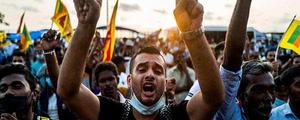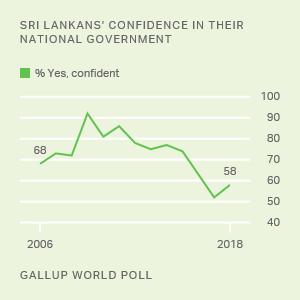Story Highlights
- Record-high three in four struggling to afford food
- Record-low 33% see economy getting better
- Confidence in government drops to 37%
WASHINGTON, D.C. -- As Sri Lanka passes the one-year anniversary of massive civil unrest that toppled President Gotabaya Rajapaksa, Gallup surveys show a nation still in crisis for the reasons that led it to that point last July: A record-high three in four (76%) Sri Lankans report struggling to afford food, while their confidence in the political system has never been lower.
Quick Summary: Many factors -- internal and external -- contributed to the political and humanitarian crisis in Sri Lanka last year. But the ailing state of the economy lay at the heart of the civil unrest.
The Sri Lankan economy was hit hard by the COVID-19 pandemic and associated drop in tourism. The recovery of the tourism industry was then halted by rising commodity prices due to Russia’s invasion of Ukraine. This made petroleum, food and medicines harder to import and fueled inflation.
In 2021, Rajapaksa banned chemical fertilizers in a push toward organic farming, and production dropped by 50% as a result. Even though this policy was eventually overturned, by then, the government could no longer afford to import fertilizer. This hollowed out Sri Lanka’s ability to feed its people.
Last July, hunger caused by deteriorating economic conditions drove thousands of protesters to Colombo, the capital. There, sustained pressure forced the resignation of President Rajapaksa.
In spite of this and the accompanying changes in political leadership, the island nation's economy is estimated to have contracted by 9.2% in 2022 and is expected to shrink a further 4.2% in 2023, according to World Bank data. A year after the political crisis, the Sri Lankan economy is struggling on all fronts. Sri Lanka recently approved a proposal to restructure its U.S. $42 billion worth of domestic debt after defaulting last year for the first time since it gained independence in 1948. Even though some stability has been achieved, crushing debt, tax hikes and high inflation remain.
Economic Crisis Exacts Heavy Toll on Sri Lankans: Three in four (76%) Sri Lankans now struggle to afford food, the highest on record and second-highest in South Asia behind Afghanistan (86%).
The local employment market has also suffered. Around 300,000 Sri Lankans have left the island in search of foreign employment, and one in three (33%) Sri Lankans feel it is a good time to look for a new job in their local area. The future doesn’t look much brighter: The proportion of Sri Lankans who feel their local economy is getting better dropped to a record low of 33% in 2022.
Faith in Leadership Collapses: Until 2021, Sri Lankans' confidence in their national government had never fallen below a majority. But in 2022, it stood at just 37% -- a decline of 55 percentage points since its 2009 peak (92%) -- representing its lowest point on record.
Just as national confidence in the government collapsed, perceptions of corruption soared to new heights. A record 84% of Sri Lankans now believe corruption in government is widespread.
People in the mostly rural North West of Sri Lanka -- also hit hard by economic decline and food insecurity -- are most disillusioned with the state. Just a quarter (24%) of residents have confidence in their government, and 93% perceive corruption as widespread.
Bottom Line
The humanitarian crisis in Sri Lanka reflects the dual setbacks of a challenging macroeconomic environment and political upheaval. Over a decade after the end of a brutal civil war, events in Sri Lanka show that the path to prosperity is rarely straightforward.
Whether tourists return in greater numbers and commodity prices fall this year will be determined by geopolitical developments far from the shores of the island nation. But the political choices of the ruling class can still ensure that ordinary Sri Lankans have a better year than the one that just passed.
To stay up to date with the latest Gallup News insights and updates, follow us on Twitter.
For complete methodology and specific survey dates, please review Gallup's Country Data Set details.
Learn more about how the Gallup World Poll works.



